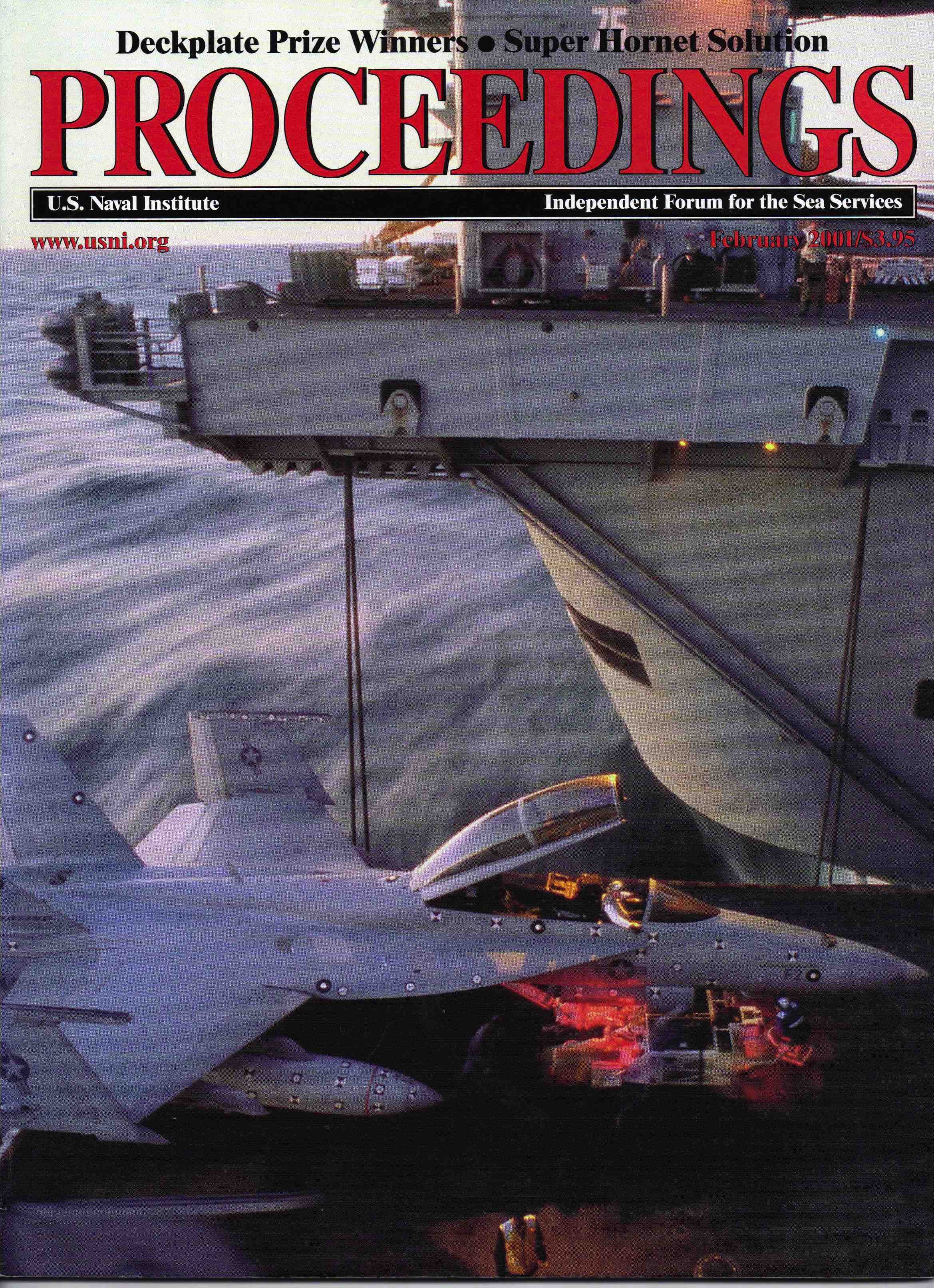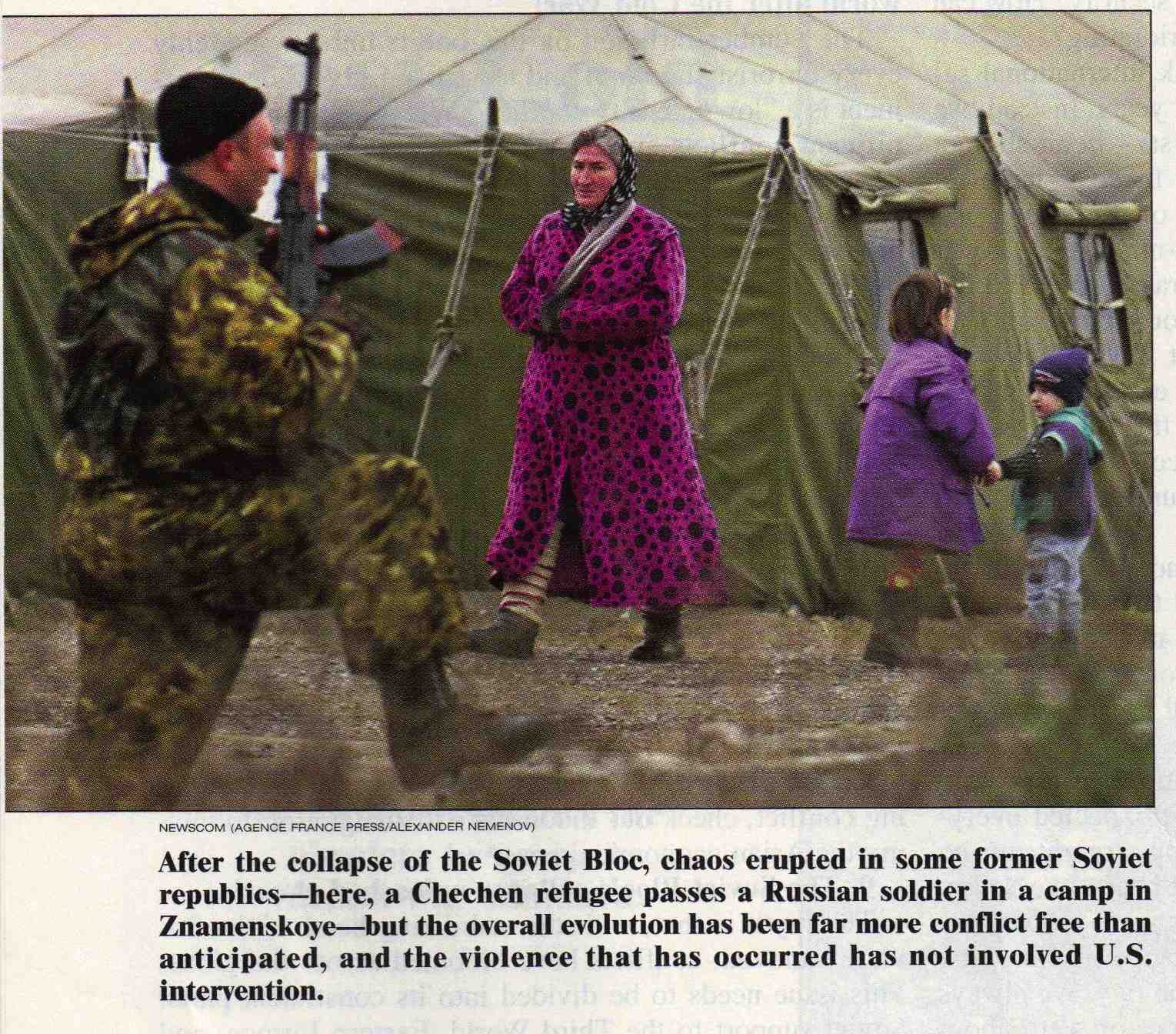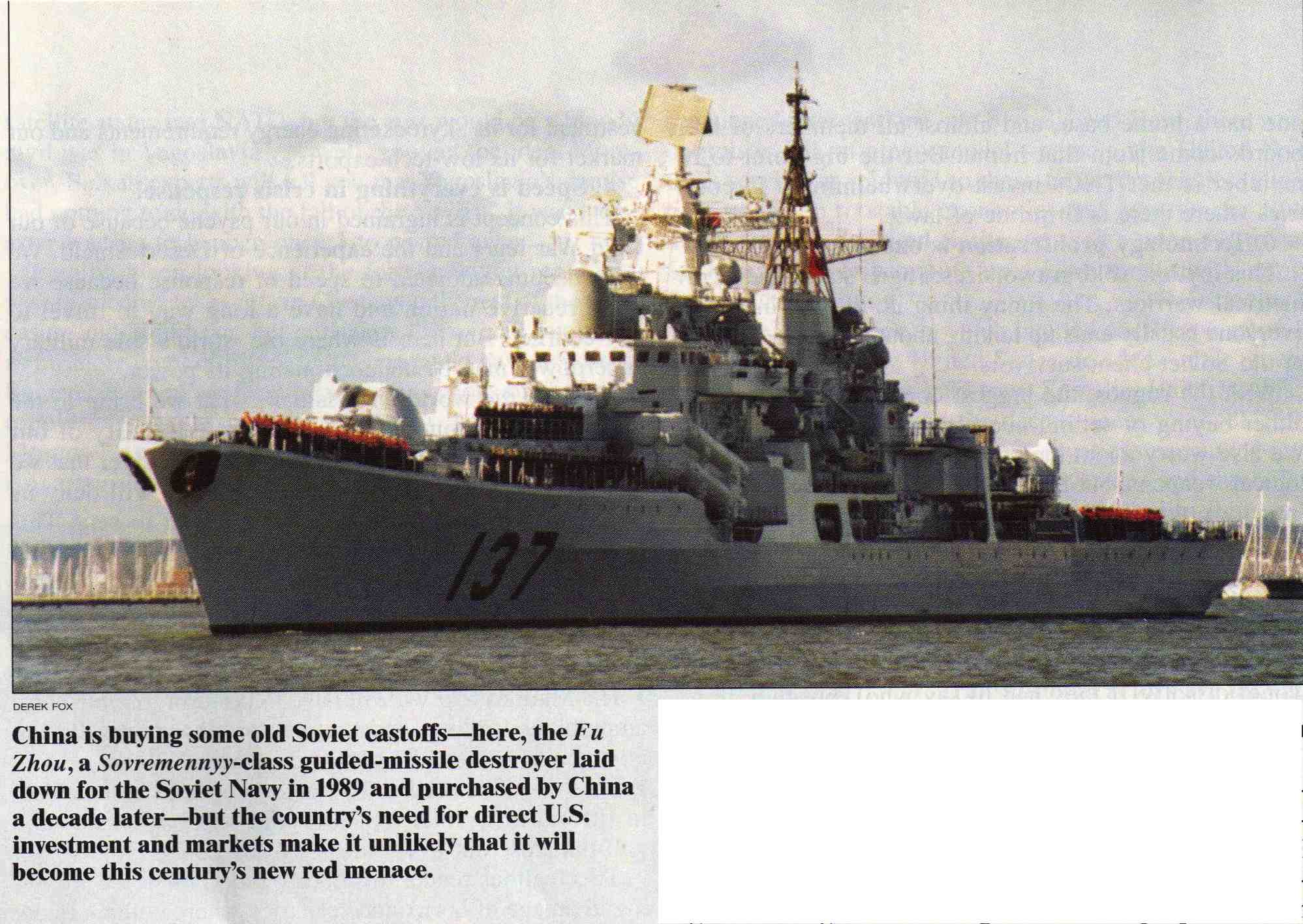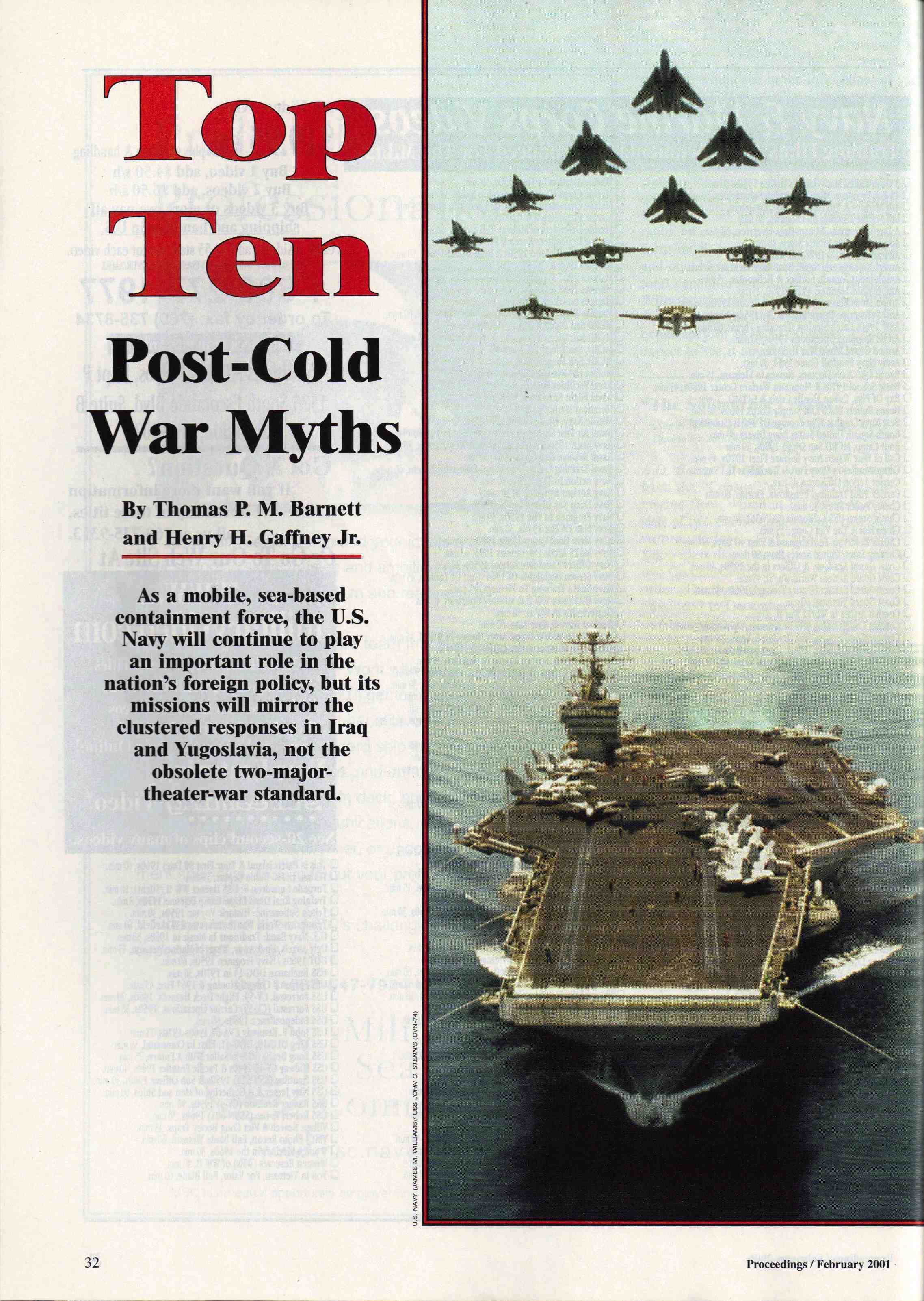Blast from my past: "India's 12 Steps to a World-Class Navy" (2001)
 Friday, August 6, 2010 at 12:01AM
Friday, August 6, 2010 at 12:01AM India's 12 Steps to a World-Class Navy
by Thomas P.M. Barnett
The International Fleet Reviews in February showed off its impressive fleet; now the Indian Navy must determine how it wants to use it.
COPYRIGHT: The U.S. Naval Institute, 2001 (July issue, pp. 41-45); reprinted with permission
In February of this year ... I had the pleasure of attending the Indian Navy’s first-ever International Fleet Review in Mumbai, where I made a presentation to a symposium audience of 16 chiefs of naval staff and dozens of flag officers from an additional 13 navies. This fleet review, which went by the motto “Bridges of Friendship,” essentially was the Indian Navy’s “coming out” party after many years of building up and modernizing its force structure, mostly through foreign purchases.
You may ask, “Coming out for what?” Frankly, that was the real theme of the high-powered symposium, as well as of numerous discussions I had with Indian flag officers, both active and retired. In many ways, this grand celebration was the swan song for a generation of Indian admirals who propelled this once humble coastal force to its current heights as the world’s fourth-largest navy. Not only do they want the international community to take note and show some respect, but they also are looking for some clear sense of where their Navy fits in this messy post-Cold War security environment.
Future Pathways of the Indian Navy
It is fair to say that every Indian admiral I spoke with represented his own school of thought, but I sensed two broad strategic factions, which I dub the Soviet School and the British School. This division recalls not only the perceived operational disparity between the Eastern and Western fleets (the former long considered the “Russian half” of the Indian Navy; the latter the “British half”) but also the difference between a land-oriented great power’s strategic employment of naval force and that of a sea-oriented one. Not surprisingly, most of the British School admirals I met had studied at the U.S. Naval War College. Conversely, I could discuss my love for Russian poetry—in the original—with those of the Soviet School.
I further subdivide each school into two wings: those admirals who believe the Indian Ocean “belongs” to the Indian Navy (and not to any “meddlesome outsiders,” including the U.S. Navy) and those who believe the Indian Navy “belongs” to something larger—typically, the collective good of global maritime security.
Putting those two axes together, I see four future pathways for the Indian Navy:
- Minimum-Deterrent Navy (Soviet School/regional focus). This is the weakest long-term outcome because it relegates the Navy to an adjunct to the Army and Air Force in India’s continuing nuclear arms race with Pakistan. This tendency most recently is demonstrated in New Delhi’s declaration to remain “equal” to any Pakistani move to put nuclear missiles on its submarines.[1] Recalling the Soviet Navy’s bastion strategy, this is a go-nowhere, do-little navy.
- Sea-Denial Navy (Soviet School/global ambition). This is an anti-China navy that seeks to export an antiaccess strategy to the South China Sea. Like the old Soviet fleet, it focuses on antiship capabilities with an emphasis on attack submarines. In its most aggressive form, it might be construed by some as an anti-U.S. navy in terms of its modest capacity for power projection toward the Persian Gulf. During the fleet review’s grand finale, Indian naval commandos demonstrated their quick-strike skills by planting explosive charges on three mock oil rigs in Mumbai’s Back Bay. They demolished the platforms to the delight of the huge crowds lining the shore, providing the VIP audience of foreign admirals a none too subtle reminder of where India resides, namely, right along the sea route that carries the majority of the world’s energy traffic from the Middle East to developing Asia.
- Sea Lines of Communication–Stability Navy (British School/regional focus). This is the polar opposite of the sea-denial navy, for it takes as its prime task the preservation of the Indian Ocean as a safe transit for global commerce. This Indian Navy seeks to supplant the U.S. Navy as the region’s sea-based Leviathan, not so much because it wants the United States out, but because India believes this is an appropriate regional security role for it to fill as its economy emerges. Another way to describe this navy is the “Mini-Me Navy,” or the Indian Navy’s regionalized version of the U.S. Navy—same rough spread of capabilities, just one-eighth the size.
- International Coalition Navy (British school/global ambition). This is the most ambitious navy, for it assumes two key developments: (1) a lessening of the land-based rivalries with Pakistan and China; and (2) a far bigger share of the Indian defense budget going to the navy, which now receives around 15%. In a practical sense, this is a “niche navy,” or India’s version of the current Royal Navy: a pro-international norms force that can deploy with some genuine reach when combined with the U.S. Navy in a multinational naval coalition. On the face of it, some nations might instinctively fear an Indian Navy of such capability, but such a long-term development would signal a secure and confident New Delhi looking to do its part for global security maintenance. As a rule, dangerous powers field large armies and air forces, not large navies.

Which navy India will end up with is anyone’s guess. Based on everything I heard in Mumbai, strong rationales exist within the Indian Navy for each outcome. But clearly, for India to achieve a world-class navy, its leaders have to move beyond viewing the fleet as a supplemental tool in New Delhi’s long-standing rivalries with its neighbors, toward an expansive security vision that takes into account the nation’s global economic status as an emerging information-technology superpower.
A 12-Step Program for the Indian Navy
India’s naval development has progressed to where its leaders need to elevate their vision beyond what the force can provide the country in terms of security to the larger issue of what it can provide the world in terms of stability. I see this as a 12-step program, borrowing liberally from the self-help literature so popular in the United States today. In effect, the senior officers of the Indian Navy need to:
1. Admit they are powerless over the Army and Air Force in determining national security priorities. Over the years India’s best and brightest did not join the Navy; there were a lot more opportunities to launch glorious military careers in the north against either the Pakistanis or the Chinese. But even if the ground pounders rule the military roost, their definition of national security is mostly internalized (what happens here), whereas the naval definition should be almost exclusively externalized (what happens over there). By my scoring, India is not a legitimate great power until it generates a surplus of external security—beyond what it needs to protect the country from outside attack. Once achieved, either New Delhi markets that surplus externally as a collective good or it ends up scaring the hell out of the neighbors. So let the Army and Air Force set India’s national security priorities, but the Navy needs to establish India’s international security priorities because only the Navy can make that sale.
2. Believe that a greater power—globalization—can elevate their force to strategic vision. As one Indian commander complained, “We are strategic suckers!” What passes for grand strategy in the Indian military is nothing more than “J & K tactics”—India’s long-simmering, high-altitude version of trench/guerrilla warfare with Pakistan over the disputed Jammu and Kashmir region. Nuclearizing the fleet on Karachi’s say-so might seem the prudent tit for tat, but it hardly constitutes a strategic naval vision when the leaders in your industry have long since turned in their tactical nukes and loaded up on precision-guided missiles. Globalization is splintering the concept of national security, generating new markets for both supranational and subnational security, two venues in which naval forces offer unique response attributes. Through its information technology sector, India is becoming a major player in the process of globalization, sporting more millionaires than any country in the world.[2] At some point, it will be asked to give something back, and a visionary internationalist navy will answer the mail nicely—so long as it is good for something other than humping lots of nukes around territorial waters.

3. Make a decision to turn their Navy’s operational focus toward influencing events ashore. I was both gratified and amazed to hear so many Indian admirals refer to the 1992 white paper, “. . . From the Sea” as a great turning point in naval strategy—gratified because I had a small role in shaping that document, amazed because I always had assumed the Indians looked more to Gorshkov than Mahan. Granted, there was some waxing nostalgic about the “spectacular Soviet Navy,” and more than a few Indian admirals revealed bitterness about Washington’s efforts to “demonize” the Indian Navy because of its old Soviet (and now Russian) ties. But by and large the flags revealed a real admiration for the U.S. Navy’s effort to shift from a blue-water to a littoral focus. Actually, it was almost an envy, simply because the U.S. Navy seems to know what it wants to do once it gains access to “events ashore,” and the Indians have not really made that cognitive leap. They know they want the capability; they just are not sure yet how they would use it. Again, this is because the Indian military acts as though security is something they import, like so many Russian subs, not something they export to the world.
4. Make a searching and fearless inventory of their lack of involvement in recent international coalitions. In his impressive symposium presentation, retired Indian Navy Rear Admiral K. Raja Menon noted how the Indian Navy has avoided numerous opportunities over the past generation to join multinational maritime coalitions in response to significant regional instabilities (e.g., tanker wars, Iran-Iraq war, Persian Gulf War), even though the Indian Army has long played a significant peacekeeping role in U.N. operations. In short, he argued, the Indian Navy for far too long has pursued an excessively narrow interpretation of the role of navies in regional and international security. As he wryly stated, regional power is a lot like sex appeal: no matter how often India admires itself in the mirror, it isn’t a regional power until outside powers recognize it as such. Or as I would put it, India seems less the regional power precisely because it does not employ its navy in the manner of a sea-based great power. A small power may have regional interests, but only a great power has regional responsibilities.
5. Admit their mistakes in force structure planning. Despite the scrappy genius of their plug-and-play approach to purchases of foreign platforms and systems, the Indians have not made much of a transition to a post-Cold War naval environment. As some younger officers complained, the Indian Navy still remains far more suited to the sort of open-sea ship battles associated with World War II than to the littoral-focused strategies of network-centric warfare. In a nutshell, the Indian Navy remains an antiship missile in a cruise missile world. It talks a good game on influencing events ashore, but it continues to buy for sea denial. But maybe that is an inevitable outcome from purchasing the bulk of your naval platforms from the world’s great land power.
6. Understand they are a relatively young navy, with the shortcomings that come from a lack of international experience. I was struck by how many retired Indian flags kept referring to their navy as young, or even adolescent. Despite a naval tradition going back to antiquity, Indian admirals will tell you that their beloved institution still has a lot of growing up to do. In their minds, it takes a century to mature a navy, so February’s grand celebration marked just the rough halfway point to what they dream the Indian Navy is capable of becoming. I could not help but imagine the Indian Navy as a young man who, having been abandoned in his infancy by his father (Royal Navy), was forced to spend his youth with his eccentric aunt (Soviet Navy) but now wants to break out and see the world for himself—or perhaps with his rich, world-wise uncle (U.S. Navy). And if that makes it sound like the Indian Navy has a complex, conflicted, almost love-hate relationship with all three navies, then it is an apt metaphor.

7. Expand their nation’s security paradigm beyond the “sacred soil syndrome.” This is another golden nugget from Admiral Menon, who describes this “cult of the land forces” as stemming from past wars with China (1962) and Pakistan (1965, 1971). Strangely enough, it is possible to argue that no other state in the world should care either more or less than India about the sanctity of its borders. On one hand, no nation has lost more land since World War II (e.g., Pakistan, Bangladesh). On the other hand, no economy today better demonstrates the “death of distance” associated with information technology—India produces roughly half of the world’s software, literally phoning it in to the rest of the global economy. In New York Times columnist Thomas Friedman’s lexicon, India is at once a leading “lexus” economy (i.e., high-technology producer) and a classic “olive tree” society (i.e., still fighting over seemingly meaningless bits of land).[3] Granted, the sacred soil syndrome is not going to disappear anytime soon, but some strategic balance is needed. And in the military world, such vision can come only from the naval service.
8. Improve their relationships with all small littoral neighbors. In many ways the Indian Navy would like to supplant the U.S. Navy as the Indian Ocean’s naval, networking Leviathan—the trusted big brother everyone can turn to in moments of trouble. In some ways, this will never happen. By definition, any region’s smaller powers want and need a distant friend who can stand up to the neighborhood bully, and for many small littoral states, India comes closest to fitting that pejorative title. From India’s perspective, they’re damned if they do and damned if they don’t: if they try to act the part of regional hegemon, they will only scare smaller powers into closer reliance on U.S. naval power, and yet in the absence of any productive input, India has a hard time demonstrating to its neighbors that it can play a useful, leading role in enabling regional security. In sum, India possesses too large a navy not to play a bigger stabilizing role in the Indian Ocean—especially as the waterway’s role in world energy transfers increases—but it needs to build relationships of trust with its smaller neighbors slowly over time.
9. Make some amends to regional rivals. The obvious candidates here are Pakistan and China, neither of which made it to the fleet review, and that’s too bad. Pakistan was not invited, and China refused to come because its ally was excluded. India can build all the “bridges of friendship” it wants across Asia, but so long as those two countries remain quasi enemies or at least heated rivals, it is hard to see India achieving the sort of progressive, stability-enhancing regional role it desires for its growing navy. And again, that’s too bad, for no ocean is in need of strategic stability more than the Indian Ocean, which is arguably the most nuclearized of the seven seas.[4]
10. Make an inventory of the global maritime insecurities they need to play a more prominent role in reducing. The Indians are fond of pointing out that not only do they sit astride the two most important commercial straits in the world (Hormuz and Malacca), but they also are situated smack dab between two of the most important narcotic centers—the Golden Crescent to the West and the Golden Triangle to the East. Toss in the fact that modern high-seas piracy is especially concentrated in the Indian Ocean and South China Sea, plus all the overlapping sovereignty claims in both, and you have a sizeable security agenda for any would-be regional naval power. And when you get all those houses in order, get ready to tackle environmental damage, rising ocean levels, and altered weather patterns. In sum, India’s growing naval power could be put to good use across a very broad range of regional collective security needs.
11. Seek an expanded navy-to-navy relationship with the world’s sole military superpower. U.S. naval presence in the Indian Ocean littoral isn’t going away any time soon. There are simply too many states there that want the collective good the U.S. Navy is selling, and it is a trusted brand with a long, solid reputation. If you look at U.S. naval crisis response over the past quarter-century, it is apparent that this area is the Department of Navy’s operational center of gravity. As former Indian foreign secretary J. N. Dixit commented about increased U.S. naval presence in southwest Asia following the Persian Gulf War: “These are the facts of life.” India becomes a genuine naval regional power only in conjunction with the U.S. Navy—not in opposition to it, or even as a marketed alternative. The U.S. Navy is the Microsoft of world navies; it simply sets too many operational standards and protocols to be ignored.
12. Having achieved this awakening from the strategic isolation of the Cold War, carry their new message of internationalism to the world. This year’s International Fleet Review was a great start. The Indian naval leadership brought me to this star-studded gathering to—as one retired vice admiral put it—“say something about the future to the junior officers in the back of the hall.” But they also brought me to Mumbai, just as they brought all those foreign flag officers, to impress upon me a sense of all they have accomplished in building this navy over the past five decades, and what they hope to do with it in the future. And I did go away impressed, not only with the Indian Navy, but also with the incredible diversity, vibrancy, and ambition that is today’s India.
Why India Matters
As noted diplomat Sashi Tharoor argues, India is probably “the most important country for the future of the world.”[5] If globalization succeeds in the United States or the European Union, no one will be too surprised. After all, globalization demands less change of these countries than it does of the world around them. And if globalization fails in China or Russia, many likewise will be unsurprised, for it requires much change from both societies—perhaps too much too quickly.
But whether globalization succeeds in India should interest just about everyone around the world. For if globalization can succeed in a democratic society where half the population is illiterate and terribly impoverished, then it can succeed just about anywhere. Conversely, if it can’t succeed in a free-market economy that features the world’s largest pool of information technology workers, then there is little hope for much of the world’s population.
Not too long ago Secretary of Defense Donald Rumsfeld characterized India as a country that is “threatening other people, including the U.S., Western Europe and countries in West Asia.”[6] In my dealings with Wall Street as part of a Naval War College project on globalization, I have spoken with a number of financial executives about India and its role in the global economy, and naturally I have found quite a different appreciation there.[7] In fact, besides China, there is no country in the world about which there is such a huge gap between how the U.S. security establishment and the U.S. financial establishment view—respectively—the security “threat” and the economic “opportunity.”
India suffers some profound military insecurities—the sort that often derail a society’s best attempts to open itself to the outside world. The Indian Navy is the country’s best near- and long-term instrument for positively asserting itself as a force for both regional and global stability. The Bush administration needs to think seriously about what sort of security relationship it wants with India in the coming years. Deputy Secretary of State Richard Armitage’s May trip to New Dehli was a huge step in the right direction, signalling an easing of the restrictions on military contacts imposed by the Clinton Administration following India nuclear weapons tests in 1998. Let’s hope it jump starts a far broader menu of strategic cooperation.
[1] As India’s Defense Ministry spokesman P.K. Bandopadhyay declared, “We are also fully prepared for the deployment of nuclear missiles by them.” See The Associated Press, “Pakistan Planning Fleet With Nuclear Weapons: India Vows to Match Submarine Deployment,” International Herald Tribune, 23 February 2001, p. 1.
[2] Good estimates vary from 15 to 20 million millionaires. India is estimated to possess a middle class of about 200 million.
[3] See Friedman’s The Lexus And The Olive Tree: Understanding Globalization (New York: Farrar Strauss Giroux, 1999).
[4] Among the nuclear powers whose navies ply this ocean are the United States, United Kingdom, France, Russia, China, India, Pakistan, and Israel.
[5] Sashi Tharoor, India: From Midnight to the Millennium (New York: Harper, 1998 paperback), p. 3. Tharoor actually quotes British historian E. P. Thompson with this phrase.
[6] This quote was run on the front page of The Times of India during the fleet review. See Siddharth Varadarajan, “Stop supply of N-fuel to India, U.S. tells Russia,” The Sunday Times, 18 February 2001, p. 1.
[7] To learn more about the Naval War College’s NewRuleSets.Project and to access its reports, visit us online at <www.nwc.navy.mil/newrulesets>.
Dr. Barnett is a former professor at the U.S. Naval War College, and served as a senior strategic researcher in the Decision Strategies Department of the Center for Naval Warfare Studies. He thanks Professor Bradd Hayes, Professor Hank Kamradt, Rear Admiral Michael McDevitt, USN (ret.), and Dr. Lawrence Modisett for their input to, and feedback on, this article.






















